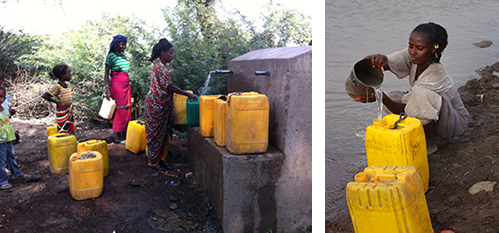15.2 Behavioural indicators
Following on from the definition of an indicator in Box 15.1, behavioural indicators are measures used to assess progress towards achieving targets of a behaviour change intervention. There are several different types of behavioural indicator that can be used in M&E programmes to measure process, outputs, outcomes and impacts.
- Process indicators measure the ways in which planned activities have been implemented, with respect to both time schedule and the quality of the implementation. Examples could be the number of effective training sessions to help people (e.g. health extension workers (HEWs) and health development army members (HDAs)) to improve their counselling skills, the number of effective posters produced or the number of community conversation groups formed.
- Output indicators measure the extent to which the planned activities have actually been implemented. Examples could be the number of street shows organised, the number of posters actually displayed, the number of group meetings organised or the number of counselling sessions completed. It is important to note that output indicators do not measure actual outcomes such as behaviour change or increase in knowledge of the target audience.
- Outcome indicators measure the outcomes that a particular project hopes to achieve, as identified in the communication plan objectives. Outcome indicators give an indication of whether the project is having an impact. Examples could be the percentage of mothers washing their hands with soap, the percentage of households that made use of handwashing facilities, the percentage of people who correctly identify the critical times for handwashing, etc.
- Impact indicators measure the long-term effects, or end results, of a project. It takes longer to obtain these so they may not necessarily be captured in the evaluation of a short duration campaign. Examples of impact indicators could be a change in child death rate, a change in diarrhoea incidence rate or a change in neonatal and infant mortality.
Imagine you want to reduce the incidence of diarrhoeal diseases in your locality. You are encouraging people to use a clean water source for drinking (Figure 15.3) instead of using water from a pond (Figure 15.4).
 Figure 15.3 (left) Safe water source and Figure 15.4 (right) Unsafe water source.
Figure 15.3 (left) Safe water source and Figure 15.4 (right) Unsafe water source.Listed below are measurements you might obtain. What type of indicator is each one?
- a.Change in number of people who take water from the new clean water source each day.
- b.Number of leaflets produced to discourage people from drinking water from the pond, and to raise awareness of the new water supply.
- c.Number of these leaflets actually distributed.
- d.Change in number of people collecting water from the pond.
- e.The incidence of diarrhoeal diseases.
The answers are as follows:
- a.Outcome indicator: this indicator will tell you if you have succeeded in encouraging more people to use the clean water source.
- b.Process indicator: this is a measure of the actions you took.
- c.Output indicator: this measurement will indicate how many people received your leaflet (but it does not tell you if they read it).
- d.Outcome indicator: this indicator will tell you if you have succeeded in discouraging people from collecting water from the pond.
- e.Impact indicator: this will measure the long-term result of your campaign. If people are using clean water the incidence of diarrhoeal diseases will go down.
15.1.2 What is evaluation?
